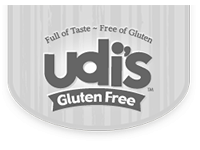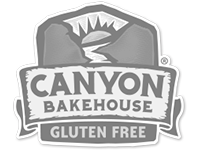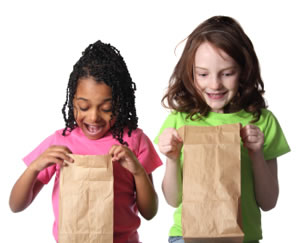Gluten Free
What does following a gluten-free diet mean? That you're embarking on an easy diet with a wide range of health-promoting effects. Instead of dwelling on what you’re giving up, consider that you’re going to enjoy a whole new world of delicious food options to meet your special dietary needs. You’ll be eating seasonally, choosing more fresh fruits and vegetables, focusing on meats, seafood, poultry, legumes, lentils, corn, and rice, and discovering fascinating ancient grains such as quinoa, amaranth, and millet. You’ll be able to eat potatoes, eggs, most cheeses, even chocolate (!)—and enjoy them without guilt because you’ll be taking good care of your body. In fact, you’ll probably end up eating—and feeling—better than ever!
Visit this page for more information about living Gluten Free
---
We carry a large variety of gluten free items, the brands listed below represent just some of the offerings we carry















More Diets

Related Topics
-
How to Host a Great Gluten-Free Kids’ Party
-
Gluten-Free Recipes
-
From "Gluten-Fear" to Gluten-Free
-
Gluten Sensitivity Beyond the Gut
- By Suzanne Dixon, MPH, MS, RD
School Lunch Savvy for Gluten-Free Kids
Anyone with a child who needs to avoid gluten knows that meals outside the home can present the occasional challenge, but a little planning can make gluten-free school lunches a snap. Between the wide range of gluten-free products on the market and the great lunch box staples that are gluten-free anyway, you always have plenty of options when packing your child’s lunch.
To help your child avoid feelings of 'food envy,' include at least one or two items in each lunch that look and feel just like their full-gluten counterparts
Gluten-free refresher
Remember that gluten can be found in many guises, including any product that contains wheat, barley, rye, spelt, durum, einkorn, graham, semolina, bulgur wheat, spelt, farro, KAMUT wheat, triticale, malt vinegar, malt flavorings, and oats (gluten-free oats will be labeled as such).
Look out for hidden sources of gluten, too, which may include:
- natural and artificial colorings and flavorings,
- clarifying agents,
- dextrin,
- emulsifiers,
- starch and modified food starch,
- hydrolyzed plant and vegetable proteins,
- maltose and dextrose,
- stabilizers, and
- broths.
When in doubt, read the label. If you’re still unsure after an ingredient check, skip the product, or call the manufacturer to ask if it is gluten-free.
Go-to gluten-free foods
Mainstream grocery stores now carry a range of gluten-free breads and crackers, which you can pair with cheese as a good lunch box starting point. Many “block” cheeses, such as cheddar, Colby, mozzarella, muenster, provolone, and pepper jack are typically gluten-free, but be sure to check the label to be certain.
If a packaged food does not indicate gluten-free on the label, it may not be. Most cheeses that are gluten-free will say so. You can try the manufacturer’s website for more information as well.
Pair some lunchmeats with gluten-free breads and crackers, too. Many fresh-from-the-deli products, such as freshly sliced turkey or chicken, will be gluten-free, but more processed lunchmeats, such as bologna, salami, pastrami, ham, and hot dogs are more likely to contain gluten.
For variety, nut butters can be a lifesaver. From almond and sunflower seed butters to pumpkin seed and cashew butters, the flavor options are enough to please the pickiest palate. Pair nut butters with gluten-free jams or jellies for a kid-friendly lunch favorite.
Remember naturally gluten-free foods
Don’t forget about fruit and vegetables, which are naturally gluten-free. Since adults and kids alike get bored with the same-old apples and bananas, mix it up with pears, grapes, berries, oranges, pineapple, watermelon, and kiwi. For younger kids, cut some fruit, such as pineapple and watermelon into fun shapes, or squares, circles, and triangles for a surprise for your little one. Pair veggies with hummus, gluten-free bean dip, or gluten-free salsa.
Dried fruit and nuts are a perfect lunch box addition, but again, check labels to make sure these are gluten-free. Some dry roasted nuts do contain gluten, but most nuts do not. If snack time is a part of your child’s school day, nuts and dried fruit can fill in here too.
Educate your youngster
Education about the importance of eating only “safe” food from home is essential for gluten-free grade schoolers. Try to avoid scare tactics and instead talk calmly about how and why a child needs to stick with his or her “safe” foods to feel good is essential. Be sure to revisit the topic at the start of each school year and if your child seems to be having symptoms of accidental gluten exposure.
A lunchtime ritual at many school lunch tables is food trading, but for the child who needs to avoid gluten, this isn’t an option. To help your child avoid feelings of “food envy,” include at least one or two items in each lunch that look and feel just like their full-gluten counterparts. If you allow it, a small treat, such as a gluten free cookie, or small piece of candy can lessen the temptation to try another child’s tasty looking dessert that, undoubtedly, will contain gluten. Teachers and other caretakers may also help you learn where your child has the hardest time forgoing forbidden foods at school, daycare, and so on, so you can adjust your strategy accordingly.











